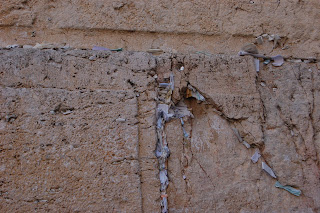I FINALLY found free Internet again! Anyway...backtrack to Sunday.
When I signed up for an 8 day tour of Israel, I thought that it would be very meaningful to see all the Holy Lands. And don’t get me wrong, the tour has in part been very powerful. But what disappointed me was that above each site is now a church, built to commemorate such a holy event. Not only that, but those who own the property now charge admission prices for sight-seers to view that holy event, and vendors around the site sell goods that capitalizes on the fact that, for example, here was the place Jesus turned water to wine (there were in fact a LOT of wine in the gift shops at Cana).
It all just seems so…irreverent.
The fact of the matter is while it is significant to me what Jesus did in those areas, the event is in the past. And we have just as much access to Jesus anywhere else. I can’t help but feel like the reverence people attach to the Holy Lands is bordering idolatry. But then it could just be that I am in need of a good dose of reverence in my own life.
For me personally, the Holy Lands are a reminder of the nearness of God, and the fact there are still remnants of his corporeal visit on this planet, and that’s about where it ends for me.
That being said, we visited a few places of significance today.
The first site we visited was Cana, where Jesus performed His first miracle. The Biblical wedding took place in a house, on top of which today sits a church. We were able to walk downstairs and see remains of the original house as well as some cisterns they were able to recover. It was in cisterns such as the ones we saw that the water was converted to wine.
The second site was Nazareth, specifically the annunciation site where Mary was visited by Gabriel. On top of Mary’s house today is now the largest church in the Middle East. Many countries donated to build that church, including the United States (who now has a LARGE sculpture inside the main sanctuary to evidence its contribution). A smaller altar sites on the first floor, and just behind one of the altars is the entrance to Mary’s house. Mass is held at this church regularly – in fact, we even sat in on the service for a bit and took pictures (which felt fundamentally wrong to me, but hey, when in Rome…er, Nazareth…)
Finally, we went to Beit Shean which was, as Alex describes, the Las Vegas of Roman cities. Back in Old Testament times it was where Saul and his sons were hung after they were killed in battle. During the Roman era, it became one of the flashiest Roman cities. This is one of the major excavation sites in Israel, and only about 5% of the city is currently uncovered. However, Alex was able to give us a tour of the theater, the elaborate bathhouses, some residential areas, outdoor theaters, the amphitheater, and the main street.
I was wondering why I was petering out so quickly lately during the tours. Part of it is touring is hard work, and I’ve been at it for a week in a half. Another part, I found out today, was the temperature was about 110 degrees Fahrenheit…in the shade! Not only that, but we are pretty much below sea level this whole time. After a Falafel lunch, we drove back to Jerusalem where we will be staying in the same hotel for FOUR NIGHTS (!!) (That is a luxury at this point, trust me). Today marks the halfway point of my time in Israel. Let’s see how the second half of the trip goes!






















































